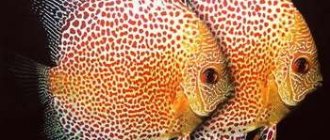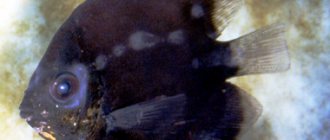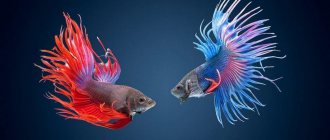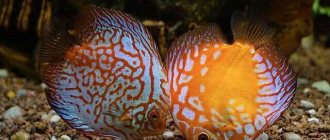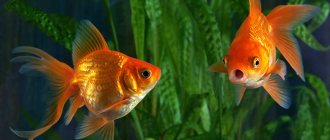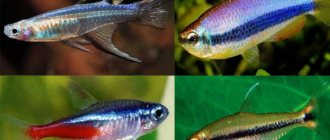Discus fish are beautiful, brightly colored fish that require special conditions. Owners know that their water must be clean and with strictly defined temperature and pH parameters.
Discus fish are delicate by nature and sensitive to their environment - these characteristics make them more susceptible to disease. The most commonly found in aquariums are Symphysodon discus, Symphysodon aequifasciatus and Symphysodon haraldi.
The main reason for their weak immunity is the selective origin of these species and the difference between natural living conditions and aquarium conditions.
The homeland of these fish is the waters of the rivers of South America, which in their composition differ from tap water in their softness and high acidity. In an acidic environment, the vital activity of bacteria and microorganisms is suppressed. Regular H2O does not have the same effect on pathogens. Below we will talk about the most common discus diseases:
Hexamitosis - defeat by flagellates
This invasive intestinal disease is widespread among aquarium inhabitants. Also known as octomitosis and hole disease. The causative agents of this disease are intestinal flagellates (Diplomonad flagellates), although there is controversy about this.
Flagellates.
Flagellates are single-celled organisms (diplomonas) belonging to the genera Trichomonas and Bodomonas. They differ in the structure of the nuclear apparatus, body shape and the number of flagella. They can disrupt the normal functioning of the intestines and disrupt metabolism.
The body does not absorb microelements and nutrients in the required quantities. Gradually, bone and connective tissue are destroyed, as a result of which animals develop ulcers and abscesses on the head, skin erosion - hexamitosis.
Parasites reproduce by division and can also form cysts. Mature cysts, entering the water with the excrement of affected fish, can cause infection of all inhabitants of the aquarium.
This disease can be almost asymptomatic at first. Then ulcers appear on the head, and if the animal is not treated, it will eventually die.
Signs of the disease
The photo shows a manifestation (ulcer on the head) of hexamitosis in discus fish.
- Thread-like excrement is transparent, whitish in color, sometimes the discharge of almost undigested food
- Growth slowdown
- Darkening of color
- Separation from the pack
- Sick individuals become lethargic and lose their appetite.
- Exhausted look
- The appearance of ulcers on the head. Holes from 1 mm to 1 cm in diameter
- The edges of the fins are destroyed, “burning”
Even if all the symptoms are present, only with the help of laboratory testing is it possible to determine the correct diagnosis.
When fish are fed gammarus, the excrement may also be white. Columnaria and vitiligo result in ulcers on the head and lightening of the skin.
Methods of therapy
1 way
During the procedure, place the fish in water of better quality, with additional aeration, filtration, without organic matter, ammonia.
Smoothly increase (3-4°C per day) the temperature to 32-35°C. Many species of flagellates are not resistant to rising temperatures. This method is used when adding metronidazole to water does not help. Check if the aquarium inhabitants are not suffocating .
Method 2
Treatment of discus fish with metronidazole (Trichopol) does not affect biofiltration. There is no need to place fish. The average dose is 250 mg/15-20 l. Apply the product daily for 5 days, replace 20% of the water daily. Then you can add the drug every other day, replacing only 10-16% of the liquid.
For the process to proceed effectively, it is recommended to add the drug every day.
The duration of treatment is at least 13-16 days, otherwise the disease will return . Metronidazole is applied throughout the course with powerful aeration and filtration.
If the abscesses on the head are large, then they must first be treated manually using Betadine.
3 way
A therapeutic bath with the addition of one of the following drugs:
- JBL Spirohexol Plus 250
- JBL Spirohexol
- Sera med Professional Flagellol
Such drugs are more convenient than metronidazole, since they are applied 2 times with an interval of 5-7 days. They do not disturb the biological balance.
If you discover symptoms of hexamitosis in one fish in an aquarium, be prepared to immediately treat all its inhabitants.
Introduction
— Advertising —
The name of the fish in Latin, Discus, means “disc”. Any variety of these fish has a disc-shaped body, flattened on the sides. The length of any type of discus is from 15 to 25 cm. The fish has a small mouth and head, protruding eyes with a reddish iris, elongated fins on the back and near the anus. Discus species differ so greatly from each other that it is difficult to identify common features in body color. The main color tone can be from brown to red-yellow. Nine vertical dark stripes run from the chest along the entire body of the fish.
The homeland of discus fish is considered to be Brazil and South America, where they live in the Rio Negro and Amazon river basins. In expanses of water, they move in standing water in coastal zones, where there is an opportunity to hide between the roots of trees.
In aquarium conditions, discus fish can live from 10 to 18 years.
Discus bacteria
Symptoms
Bacterial infection in discus.
- Individuals affected by a bacterial infection acquire a dark color and tuck their fins.
- They don't eat, they hide in corners
- The mucous membrane thickens in some places, the edges of the fins turn white, and gradual destruction of the tissue occurs
- Animals cannot keep their balance and lean on their side
- In advanced cases, the skin begins to peel off and the lenses of the eyes become cloudy.
How to treat
In this case, treatment of discus is carried out with the help of antibiotics Cifran, Ciprofloxacin together with Furazalidone.
Dosage: 1 tablet of Ciprofloxacin/50 l of liquid, 1 tablet of Furazalidone/10 l daily for 7 days. Don't change the water! Starting from day 8, you can start replacing H2O as usual.
Diagnostics
The diagnosis is made on the basis of anamnesis, questioning and examination of the patient, data from laboratory and instrumental studies. This is a multi-stage and rather lengthy process. The diagnosis is considered timely made if it is finally confirmed one and a half months after the patient’s first visit.
The main diagnostic methods are:
- biochemical, general, immunological blood test in children for juvenile arthritis;
- Analysis of urine;
- ECG;
- X-ray of the chest, as well as the affected limbs or spine (if indicated);
- Ultrasound of the kidneys, myocardium, abdominal organs;
- MRI (if indicated).
In addition, the child is sent to an appointment with an ophthalmologist to check the health of the visual organs.
A comprehensive examination is also carried out to determine the presence of infection in the body. It includes cultures for beta-hemolytic streptococcus, herpes virus, salmonella, toxoplasma, cytomegalovirus, chlamydia and a number of other pathogenic and opportunistic microorganisms.
Additionally, the patient may be prescribed ANA, ACPP, immunogenetic testing and a number of others. This is necessary to determine the type of arthritis and conduct differential diagnosis. Source: Nosological diagnosis of juvenile arthritis during long-term follow-up. Salugina S.O., Kuzmina N.N. Pediatrics. Journal named after G. N. Speransky, 2011. p. 29-35.
Constipation and abdominal dropsy
Description and symptoms
It is difficult to make a correct diagnosis by performing only an external examination.
In case of constipation, the discus becomes bloated in its abdomen, becomes darker, and has difficulty maintaining balance. The animal continues to feed until the intestines rupture . The cause of intestinal obstruction is a monotonous diet of poor quality.
Video: discus constipation
With dropsy, the fish does not eat, bulging eyes and excrement with white mucus may occur. Reasons for the development of dropsy: unsatisfactory living conditions, general weakening. In both cases, at the initial stage of disease, fish can be saved.
Methods of therapy
In our country, treatment of discus fish with table salt is common.
- The water temperature is set to 33-35 °C
- Dissolve 1 tablespoon of salt in 40 liters of water in an aquarium for 3 days
- The animals are not fed during the entire period.
Abroad, similar diseases are treated with epsom salt.
Epsom Salt (Epsom salt, magnesium sulfate), dissolved in 1 to 2 teaspoons / 40 liters of aquarium water. If there is no improvement, then after 4 hours, you can add another dose, which should not exceed 1 - 2 tablespoons / 40 liters of liquid over 24 hours. It may relieve intestinal obstruction due to overeating.
If the fish's condition does not improve within 24 hours, then a bacterial infection should be suspected.
The main thing is not to confuse abdominal dropsy and a bacterial infection, against the background of which bloating can develop.
Classification
Based on the nature of the course and clinical picture, the following forms of the disease are distinguished:
- Pauciarticular arthritis . Usually develops in children 1-6 years old (mainly girls). Almost always affects the knee joints. In addition, inflammation of the choroid of the eyes (uveitis) develops. If treatment is started in a timely manner, the prognosis is favorable, and the patient experiences long-term remission. If the disease is not treated, polyarthritis and severe joint damage may develop.
- Juvenile rheumatoid polyarthritis is seronegative . It is more common in girls under 15 years of age. A large number of joints are affected, including the temporomandibular joint and the joints of the cervical spine. Rheumatoid factor is not detected in the blood. In its course, this form resembles the adult version of the disease. In most cases, the prognosis is favorable, but sometimes complications arise in the form of persistent dysfunction of the affected limb.
- Juvenile rheumatoid polyarthritis is seropositive . It usually develops in girls aged 8 years and older and affects various joints. The earlier the disease starts, the worse the prognosis, including disability. ANF rheumatoid factor is present in the blood.
- Systemic rheumatoid arthritis . Does not depend on age and gender. The disease begins acutely, affecting the lymph nodes, joints, and internal organs. A high concentration of rheumatoid factor is found in the blood of patients.
- Idiopathic juvenile arthritis . Has unknown origin. Happens frequently. This diagnosis is made after excluding all other forms of the disease.
Gill or skin flukes in discus fish
Gill flukes.
Called monogenic flukes, they require only one host to complete their life cycle. These are common parasitic worms (ectoparasites) about 1-2 mm long that live and reproduce in the gills of tropical fish. Due to their small size they are barely noticeable.
Gill flukes have small hooks that attach to the gill filaments. When there are a large number of parasites, mucus plugs form, causing the gill plates to stick together. This leads to a decrease in the fish's ability to consume oxygen. She becomes lethargic and quickly dies from a bacterial infection or oxygen deprivation.
Symptoms
- A fish affected by monogenic trematodes becomes timid, restless, rubs against the decorations, isolates itself, and sometimes shows signs of lethargy.
- The gills swell, the gill covers protrude.
- An infected individual may suffocate on the surface, or lie on the bottom with its fins tightly pressed to its body.
- Sometimes one of the covers “sticks” and stops moving.
- Discus stops eating.
It is possible to accurately determine the correct diagnosis only by skin scraping or gill biopsy.
Methods for treating lesions with gill or skin flukes
Tremazole is often used to get rid of gill or skin flukes.
Numerous gill fluke control products are added to the water, but only affect hatched organisms; the worm eggs are extremely hardy. Several procedures are required over several weeks.
Tremazol treatment occurs in a dosage of 1 ml/15 l of water, after 6 hours, replace 80% of the liquid volume, and repeat the process after a week.
Additional aeration is needed, the UV lamp is turned off, and the biological filters are left to function.
Treatment with Gyrodol is similar. Dose 10 ml/40 l. The drug is dangerous for shrimp.
Foreign aquarists use the following medicinal products to treat discus fish:
- Praziquantel (also called Droncit (US) or Fluke-Solve (UK/EU), Drontal (UK), PraziPro (Hikari))
- Paragon - from Waterlife UK (mild infections) (safe for shrimp and snails)
- Sterazin - by Waterlife UK (serious infections) (not safe for shrimp and snails).
In addition, formalin treatment is used. This method is very risky, but the most effective.
1 way, domestic sources
The treatment is carried out in another aquarium at a temperature of 28 ° C and increased aeration, but without plants, soil, or filter. The fish are placed in it 24 hours before the start of the procedure.
Dosage: 8 ml/100 l. Before pouring formalin into a container with a sick fish, it is first dissolved in a liter of liquid. After 24 hours, 50% H2O is changed and 8 ml is added again. Repeat the procedure again.
The worms die, but not the eggs! They remain in the aquarium and in the gills, so on day 4 the procedure is repeated in the same way to destroy the immature worms that have just appeared.
2 way borrowed from foreign sources
It differs in dosage and duration of the procedure.
Dosage: 1 ml of formaldehyde (formaldehyde) per 40 liters of liquid. After 8 hours, 50% of the water is replaced. Do not increase the temperature. Additional aeration is required. During processing, remove carbon filtration, do not turn on lighting lamps. If after the first dose the condition improves noticeably, then you can continue the procedure every day for 2 weeks.
Important! Formalin is a poison that must be handled with care:
- Be sure to wash your hands after use
- Do not store the product in the refrigerator
- Do not use formalin with sediment due to high toxicity
As for discus breeding, there is still an opinion that this is a rather complicated process.
In fact, everything is much simpler than many people think. The main thing is the selection of manufacturers and water preparation. If you create optimal conditions for raising future producers, then you won’t have to wait long for offspring from them. A group of young discus from which we want to get fry must be kept in one aquarium. With good care, they will reach maturity at the age of 12-16 months and will break into pairs: they will swim together, twitching their fins, bowing to each other, cleaning the substrate together and driving other fish away from it. Readiness for spawning is signaled by shuddering throughout the body. Such a pair should be transplanted into a spawning tank with a volume of at least 80 liters, preferably at least 45 cm in height, equipped with an aerator and a filter (at least the simplest one - foam rubber). The temperature is maintained at 30°C. A substrate is also placed here - a plastic or clay tube, a pot or a special cone. Strictly speaking, the substrate is not of particular importance for fish: discus can lay eggs on the side glass and even on the bottom. The water should be soft (2-4°dGH), slightly acidic (pH 6-6.5), enriched with tannins. To do this, mix regular tap water with distillate and lightly peat it. On the other hand, I have more than once observed a pair of discus spawning and raising fry in ordinary Moscow water (9-12°dGH and pH 6.5-7.5), but in such conditions there is always much less fertilized eggs. When a pair has been selected and the spawning tank is ready, all that remains is to watch - a harmonious pair will do everything itself. Most often, spawning occurs in the evening. In 30-40 minutes, the female lays up to 400 eggs, which are immediately fertilized by the male. Then the discus, constantly fanning the clutch with its pectoral fins, is involved in the process of courting the offspring. They do this in turns, but more often the male. At a water temperature of 30°C, by the end of the second day the eggs darken, and after 54-56 hours the first larvae hatch. Parents move them to a clean place. On the 6th day after spawning, the moment finally comes when the larvae, increasingly breaking away from the substrate, move onto their parents to feed on their skin secretions (secret). By this time, the pair had already acquired the special coloring of “hens” appropriate to the moment: a light head and a dark body are signs of the fish’s readiness to receive offspring. If the couple is strong and calm, then you should not rush to add additional food - the juveniles are fully satisfied with the skin secretions of their parents. But after a week you can already add Artemia uplii - an ideal starter food. From this moment on, it is necessary to begin changing water in small doses in the spawning tank simultaneously with removing the remaining food. A good couple feeds their offspring for up to 1.5 months. But, as a rule, this is not necessary: after 2-3 weeks, parents and fry can be separated.
Disease Prevention
If you treat discus fish with care and follow the rules and conditions of detention, you can avoid outbreaks of diseases or localize them in time.
With proper care and compliance with all maintenance rules, your fish will delight you with their beauty for a long time.
- Do a visual inspection every day
- Provide high-quality, varied, well-balanced food
- Do not put large numbers of fish together
- Select individual inventory
- Remove sick individuals in a timely manner
- It is prohibited for pathogens to enter the vessel along with live food, plants, and soil from natural bodies of water.
- Do not transfer parasites from contaminated containers to safe ones
- Change the fluid promptly
- Remember about filters and aeration
- Siphon the soil 2-3 times a month
- Remove excrement and remaining food promptly
- Do not allow the temperature to be lower than 29 °C, monitor the water quality.
Interesting Facts
Discus fish are gregarious creatures, but they also need personal space. Therefore, larger and deeper ones are chosen to contain them.
Discus fish are almost the only fish species that feed their fry with a special skin secretion. Therefore, during the first days of life, the fry swim near their parents.
The consistency of discus fish is surprising. These fish form pairs at a young age, spawn and care for their offspring together.
Deliveries of live discus fish to Europe began in 1932; only in the second half of the 60s new varieties with original colors began to be developed.
What is tenosynovitis
Tenosynovitis is an inflammation of the tendon sheaths. The latter are tubular-shaped connective tissue filled with liquid lubricant. The sheaths surround the tendons, which are made of flexible fibrous collagen tissue. It is what attaches muscles to bones. If the outer covering of the tendons becomes inflamed, it is called tenosynovitis. Both inflammatory diseases are accompanied by pain when moving, so only a doctor can make an accurate diagnosis.
Tenosynovitis most often affects the hands, wrists and feet
